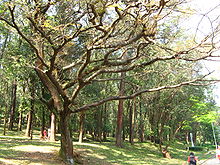
In polymer chemistry and materials science, a resin is a solid or highly viscous substance of plant or synthetic origin that is typically convertible into polymers. Resins are usually mixtures of organic compounds. This article focuses mainly on naturally occurring resins.

An essential oil is a concentrated hydrophobic liquid containing volatile chemical compounds from plants. Essential oils are also known as volatile oils, ethereal oils, aetheroleum, or simply as the oil of the plant from which they were extracted, such as oil of clove. An essential oil is essential in the sense that it contains the essence of the plant's fragrance—the characteristic fragrance of the plant from which it is derived. The term "essential" used here does not mean indispensable or usable by the human body, as with the terms essential amino acid or essential fatty acid, which are so called because they are nutritionally required by a living organism.

Balsam is the resinous exudate which forms on certain kinds of trees and shrubs. Balsam owes its name to the biblical Balm of Gilead.

Canada balsam, also called Canada turpentine or balsam of fir, is the oleoresin of the balsam fir tree of boreal North America. The resin, dissolved in essential oils, is a viscous, sticky, colourless or yellowish liquid that turns to a transparent yellowish mass when the essential oils have been allowed to evaporate.
Oil of guaiac is a fragrance ingredient used in soap and perfumery. Despite its name it does not come from the Guaiacum tree, but from the palo santo tree.
Oleoresins are semi-solid extracts composed of resin and essential or fatty oil, obtained by evaporation of the solvents used for their production. The oleoresin of conifers is known as crude turpentine or gum turpentine, which consists of oil of turpentine and rosin.

Galbanum is an aromatic gum resin and a product of certain umbelliferous Persian plant species in the genus Ferula, chiefly Ferula gummosa and Ferula rubricaulis. Galbanum-yielding plants grow plentifully on the slopes of the mountain ranges of northern Iran. It occurs usually in hard or soft, irregular, more or less translucent and shining lumps, or occasionally in separate tears, of a light-brown, yellowish or greenish-yellow colour. Galbanum has a disagreeable, bitter taste, a peculiar, a somewhat musky odour, and an intense green scent. With a specific gravity of 1.212, it contains about 8% terpenes; about 65% of a resin which contains sulfur; about 20% gum; and a very small quantity of the colorless crystalline substance umbelliferone. It also contains α-pinene, β-pinene, limonene, cadinene, 3-carene, and ocimene.

Myrcene, or β-myrcene, is a monoterpene. A colorless oil, it occurs widely in essential oils. It is produced mainly semi-synthetically from Myrcia, from which it gets its name. It is an intermediate in the production of several fragrances. α-Myrcene is the name for the isomer 2-methyl-6-methylene-1,7-octadiene, which has not been found in nature.

Caryophyllene, more formally (−)-β-caryophyllene,(BCP), is a natural bicyclic sesquiterpene that is a constituent of many essential oils, especially clove oil, the oil from the stems and flowers of Syzygium aromaticum (cloves), the essential oil of Cannabis sativa, copaiba, rosemary, and hops. It is usually found as a mixture with isocaryophyllene (the cis double bond isomer) and α-humulene (obsolete name: α-caryophyllene), a ring-opened isomer. Caryophyllene is notable for having a cyclobutane ring, as well as a trans-double bond in a 9-membered ring, both rarities in nature.
Phellandrenes are a pair of organic compounds that have a similar molecular structure and similar chemical properties. α-Phellandrene and β-phellandrene are cyclic monoterpenes and are double-bond isomers. In α-phellandrene, both double bonds are endocyclic and in β-phellandrene, one of them is exocyclic. Both are insoluble in water, but miscible with diethyl ether.

Copaene, or more precisely, α-copaene, is the common chemical name of an oily liquid hydrocarbon that is found in a number of essential oil-producing plants. The name is derived from that of the resin-producing tropical copaiba tree, Copaifera langsdorffii, from which the compound was first isolated in 1914. Its structure, including the chirality, was determined in 1963. The double-bond isomer with an exocyclic-methylene group, β-copaene, was first reported in 1967.

Copaifera langsdorffii, also known as the diesel tree, is a tropical rainforest tree. It has many names in local languages, including kupa'y, cabismo, and copaúva.

Commiphora myrrha, called myrrh, African myrrh, herabol myrrh, Somali myrrhor, common myrrh, is a tree in the Burseraceae family. It is one of the primary trees used in the production of myrrh, a resin made from dried tree sap. The tree is native to the Arabian peninsula and to Africa. It is called 'mur' (المر) in Arabic, meaning bitter. It famously comes from Mecca, so it is called 'Mur Makki'.

Copaifera is a genus of tropical plants in the legume family Fabaceae. It includes 40 species native to the tropical Americas, west and central tropical Africa, and Borneo.

Stacte and nataph are names used for one component of the Solomon's Temple incense, the Ketoret, specified in the Book of Exodus. Variously translated to the Greek term or to an unspecified "gum resin" or similar, it was to be mixed in equal parts with onycha, galbanum and mixed with pure frankincense and they were to "beat some of it very small" for burning on the altar of the tabernacle.

δ-Cadinol is an organic compound, a sesquiterpenoid alcohol produced by many plants as well as some animals and microorganisms. It is a white crystalline solid, soluble in isopropyl ether and ethanol. It is an epimer of α-cadinol.

Copaifera officinalis, the copaiba balsam, is a species of flowering plant in the family Fabaceae, native to Bolivia, Brazil, and Venezuela. It has been introduced to Cuba, the Dominican Republic, Trinidad and Tobago, Sierra Leone, India, and Sri Lanka. Like other members of its genus, its trunks are tapped for its oleoresin, sometimes termed balsam of copaiba or, when refined, copaiba oil, which has industrial, artisanal, and medicinal purposes. Its oleoresin exhibits better bactericidal activity against common pathogens than that of Copaifera langsdorffii.

Copalic acid is a chemical compound that is a constituent of copaiba oil, an oleoresin extracted from trees in the genus Copaifera. It is a diterpenoid of the labdane class.

















